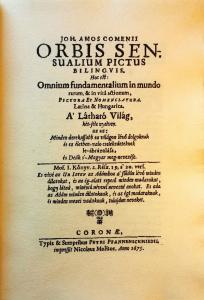
Orbis sensualium pictus
Orbis Sensualium Pictus [Visible World]
Written by Johannes Amos Comenius
Facsimile edition
NSZL, Budapest, 2003., 344 pages
This facsimile edition was made in the László Vincze and Sons Papermaking Workshop of Szentendre, on hand soaked paper, in 200 numbered copies.
Johannes Amos Comenius’s Orbis Sensualium Pictus can be regarded as the first widely used illustrated educational book made especially for children.
In the 17th century, illustrated books had been there for at least 150 years, and the idea of illustrated textbooks to facilitate efficient education also existed. Yet, the first theoretically elaborated and well completed comprehensive work of this genre was Comenius’s masterpiece. Orbis Sensualium Pictus was an enormous success for a textbook with a long row of editions between its first Nuremberg publication in 1658, and the last – apparently still to be used in schools – in Leipzig, 1910.
„Let it be given to children into their hands to delight themselves withal they please, with the sight of the pictures, and making them as familiar to themselves as may be, and that even at home before they be put to school” – says Comenius in his preface to Orbis Pictus. This is the most important product of Comenius’s activity in Hungary, a textbook for reading and language learning, a diverse encyclopedia in form of a children’s picture book. Its theory is pansophic encyclopedism, its method is based upon natural, simple and clear style. According to Comenius, the usefulness of Orbis Pictus is threefold: it helps children to memorize concepts, makes them enjoy reading, and offers aesthetic delight to „seek pleasure in books”. After the first, 1658 Nuremberg edition, the first Hungarian edition came from Samuel Breuer’s typography in Levoca in 1685. While the illustrator of the first and all the following German editions is unknown, the 151 wood engravings of the Levoca editions were provenly made by Jonas Bubenka, the Latin teacher of the Levoca Evangelical School. His pictures, also seen in the 1728 Levoca edition now kept in the University Library, exactly mirror the ones of the Nuremberg edition, proving that he copied directly from the original. In spite of the frequent errors due to the difficulties of copying in reverse for printing, his pictures were a great contribution to the success of the Hungarian version of Orbis Pictus.
Shopping
Our publications are available in our bookshop, or can be ordered from the Publications Department of the NSZL using the contact details below: Főigazgatói Kabinet kiadványtára, Országos Széchényi Könyvtár, 1276 Budapest P.O. box 1205., phone: 06 1 232-3556, e-mail: kiadvanytar@oszk.hu.




